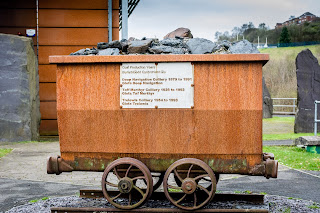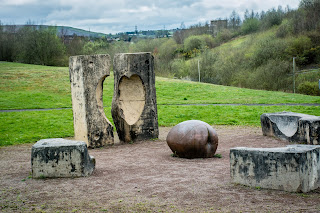A feature in South Wales is the landscaping of the old sites
of the coal industry. Throughout the area there are now a number of what are
termed ‘country parks’, where there has been an attempt to return the Valley
floor to nature. This usually involves the creation of walks and cycle paths so
that the area is accessible. On some football and rugby pitches are laid out in
an almost overly flat manner providing recreation of a different sort but
belying the contours of the true countryside. Parc Taf Bargoed is one such place
where the two aspects of the aim to offer facilities to the local population have
being combined. In these reshaped areas a convention appears to be that there is
a nod to the presence of past industry as well as sculpture conjuring up a
symbolic statement about what was and what now is.
At Parc Taf Bargoed the planner certainly has adopted the orthodoxy
for monuments and art placement, as here, there are all the stereotypical
offerings. A place worthy of a visit for this cornucopia alone.
When I visit I park my car in the designated area noting the large carved tree trunk informing me on its side where I am, (there is a more obvious sign up the road). This post has a rough-hewn outline of birds
indicating that if I watch the sky I will see kites. I watched for a while -
but none appeared. Similar carving are
doted everywhere these days and if you are interested there is a man that sells
them when its fine weekend weather in a lay-by near Storey Arms in the Beacons.
From the car park, I wander over to the Visitors Centre which
has a permanent closed look. “Not many visitors, see.” In front of the centre is its mining memorial -
a coal tub. I imagine the discussion when the planner thought about this. “Shall
we have a coal tub or a pithead winding wheel? Well there's lots of both about.
Let's go for the tub.”
There it stands now rusting with coal pieces placed to
make it look as if it's full. A plaque on its side lists the collieries that were
on this site. Deep Navigation, Taff Merthyr and Trelewis. And, yes, as always they have placed the cart
on some rails - coming from nowhere and going to nowhere - just like all the
other mining cart memorials.
I then notice a rather unusual means of recalling the pit.
Someone had the bright idea of laying out along a path the points in the pit shaft
where the seams of coal cut through and where the bottom of the shaft lay. A
translation of the vertical to the horizontal. Each coal seam is identified by its
name and depth with its approximate width laid out in rough stones across the
path.
I decide not to walk along its full length as it is quite a steep path but
I notice that this path is curved. I didn't think there were any curved mining
shafts in this area. The planner’s voice in my head says, “It doesn't matter.
It just gives an impression. It’s a representation.”
 Clearly, our planner is on a roll with the common symbols of
Wales. So he decides that by the side of the centre at the crossroads of two paths
to erect a carved stone column. Limestone with leaves on one side and a rough outline
of the river’s course on the other. A poor man's version of a Celtic cross. No
country park worthy of the name is without its carved stone column.
Clearly, our planner is on a roll with the common symbols of
Wales. So he decides that by the side of the centre at the crossroads of two paths
to erect a carved stone column. Limestone with leaves on one side and a rough outline
of the river’s course on the other. A poor man's version of a Celtic cross. No
country park worthy of the name is without its carved stone column.
I imagine my planner rubbing his hands with glee, “and while
we are on big slabs of stone and in Wales, Celts, Druids and all that …. let's
have a stone circle.”
Now, to have a stone circle requires big stones and a circle
of a 360° construction. If you are a bit short of cash or just trying to be
clever, what you do is half the circle (perhaps
a bit less) with the other half seemingly being bounded by a visitor centre type
building. The large stone pieces are slatey shale; the type of rock discarded
in the mining of coal.
In this higgledy-piggledy arrangements of memorials and monuments
our planner looks at what has being landscape in the area and sees that a blank
wall has been left in front of the Ancient Briton inspired almost half stone
circle. “Let's put some pretty graffiti on the wall. The kids will love it.” Of
course, it also stops the more serious unofficial graffiti artists who may have
added something original.
Standing back, I view the modernity of the visitor centre
with its curved roof, the Celtic stone circle and the pretty graffiti. I wonder
what else the planner can do. Then on the side of the building away from the
road, I can see the results of inspiration. “I would like to commission an imaginative piece
that speaks to the growth of the new out of the old.” When I first look at the
work, I didn't think that it was an innovative piece of art, I thought it was
some concrete shapes that children could play on next to the playground. I walk
up and I see its true intended artistic nature. There are five concrete pieces representing
a discarded outer casing of a large nut looking object that now sits in the middle.
Two of rough exterior covering stand upright providing an image of a heart - the place from which the veined nut emerged.
I walk around taking in its imagery.
It
suggests a cracking open; an emergence from a shell, an opening up of potential
growth arising out of the stone; all symbolic of the park and its history.
But wait. I look closely at the back of the nut. It is an arsehole!
“Mr Planner, Mr Planner have you seen your artistic piece from
the back. It’s an arsehole.”
Arseholes are only good for one thing.
“Symbolic, see.”
Yes and we received it …from a great height.
The point is that we can do better than this. We deserve
better than the trite staging of ‘art for the community’ and memorials. We
deserve large original pieces that express the individuality of place and
persons. We need commemorative pieces that we can identify with and be proud
of. We do deserve better than this.















